On this step of our Red and Green prototype assets coverage, we reach the surprisingly convoluted topic of Pokemon moves. Analyzing the data made us realize how understudied the topic has been. It seems that previously there were no attempts at as much as glancing over the attack list to find any clues or hints to tell us more about the way the games were developed; this is in complete contrast to the Pokémon index list, which was looked at thoroughly throughout the years and then picked apart piece by piece through collaborative effort.
(Note: this article was updated in 2021 for a few essential changes, including the availability of source files and their terminology, as well as some cleanup related to the name changes. Most of the theories we had during the making of this article that were revised later, however, have been kept intact for purposes of documenting the journey. For updates on those, read Part 2.)
What makes the subject so tough to grasp is the fact that the files that we are looking at come from different stages of development, and are often contradictory or simply incompatible with each other. Unlike the study of the Pokémon index, the framework of data – the move index list – changes its structure significantly between its iterations.
Additionally, since the data lists we have are from different periods of development, they do not directly correlate with each other, meaning that strict investigation into the data structure must be done to determine – or even just guess – the conclusions that we can draw.
The Gen 1 files we’ll primarily be looking at are two move lists, one move stats list, and one learnset list. Some of these lists were seemingly ‘extracted’ from comments tacked on to final code, internal file names, or as older saved copies of a final list – some even have turned out to be temporally inconsistent “lists” from within the same file! There are additional lists not seen in the asset leak that were found by post-source-leak inspection of the source. These minor lists have smaller variations on the data, but contribute a bigger picture nonetheless. These are listed in the Excel spreadsheet. We’ll cover the differences between the compiled lists later.
These move indices are naturally interesting because they have older names and stats for moves as well as what Pokémon learned what moves, and we can compare the lists to track where moves ended up and why. We can see the underlying creative process for how many of Pokémon’s most famous moves got their start. The learnset list also provides some movesets for lost Pokémon, meaning that decoding the list would reveal some of the original moves that the MissingNos once had. All in all, there is work to be done.
Before we speak further about these early files, we need to cover the topic of the move list from the final product. The fact that we posted our findings on the subject (see the list on the left) around the time that we were analyzing the prototype assets is no coincidence. It was during our scrupulous work on the data that we realized the logic of this information, which has been available publicly for years. You see, the move list can be divided into two major parts: Moves from 001 (Pound) to around 115 (Reflect) are nearly exclusively sorted by their type or characteristic feature – whether it be punches, kicks, variations of tackles, Electric moves, Water moves, “beam” moves, Flying moves, “bird” moves – they tend to be lumped together into small sections, sometimes even into bigger groups; for example, Fire, Water, and Ice moves are all near each other. Throughout the entire history of the franchise, 742 moves at the time of this writing, the move list is rarely if ever as well organized (or organized, period) as this part at the very beginning. Try to find a pattern behind the moves added in Gen 3 – it will make your head spin.
Next comes the interesting part. From around 116 (Focus Energy) and certainly from 118 (Metronome) up until the end of the list are moves that are seemingly disorganized and in random order – just like pretty much any further addition to the movelist in each new generation. Moves aren’t lumped together according to effect or animation, let alone type. As it turns out, this part of the move list has moves that each can be associated with one Pokémon – similar to signature moves (we’re going to use that term as a shorthand for this concept from now on). In fact, they follow the Pokémon index list. For example, moves in the range 150 to 156 (Splash, Acid Armor, Crabhammer, Explosion, Fury Swipes, Bonemerang, Rest) can be clearly associated with Pokémon from Period 4b of the index list (133 Magikarp, 136 Muk, 138 Kingler, 141 Electrode, 144 Persian, 145 Marowak, 148 Abra). The same is true for the majority of this portion of the move list, with only a few exceptions – some of which can be explained by the data in the older lists. We will make sure to cover these in detail.
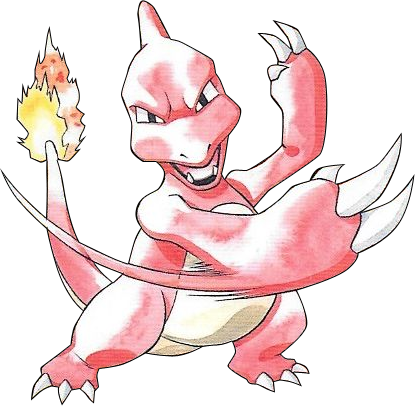
Charmeleon using Slash 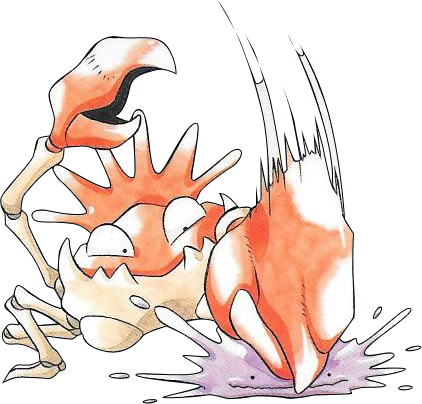
Kingler using Crabhammer 
Porygon using Tri Attack
Note that a Pokémon doesn’t even need to learn the move naturally to be associated with it. Some Pokémon might have even been designed along with their designated move, even if the move eventually ended up being used by completely different species.The connections are mostly formed through a combination of Pokémon’s gimmick or appearance and move’s name or effect – and the association is often strongly implied by lore, i.e. Pokédex entries.
The aforementioned Abra doesn’t learn Rest through level-up, but it is described as sleeping 18 hours a day, therefore its connection with the move is very plausible. Perhaps its Teleport-only moveset was a later idea. Gyarados is connected with Waterfall because of the Chinese myth this Pokémon references, and the list continues on. This prompts an interesting vision of Game Freak’s programmers working on Pokémon and moves hand-in-hand.
There are two reasons why it’s difficult to delineate the perimeters for each of the sections. First, while it can be said with utmost certainty that 115 Reflect is one of the “barrier” moves that mark the end of the first part of the movelist (together with Barrier, Light Screen, and the odd inclusion of Haze), and no doubt could be cast on 118 Metronome’s inclusion as 004 Clefairy’s “signature” move in the second part of the list, two moves in between – 116 Focus Energy and 117 Bide – show no strong features to be included in either. For all we know, 116 Focus Energy could have been associated with 003 Nidoran-M, but no such connection could be made for Bide, a move enjoying a peculiar privilege of being a TM exclusive – no Pokémon can learn it through level up. There’s an argument to be made that they could form a sub-group within the first part of the move list, but any feature connecting these two moves is debatable at best – therefore their status is inconclusive.
The second difficulty comes at the very end of the move list. Relatively widely-used move 163 Slash seems to have been initially associated with the Charmander line (176, 178, 180), but 164 Substitute has no clear user – we’ll return to that move later on. 165 Struggle marks the end of the move list, but the general consensus within Helix Chamber is that the characteristics of the move caused the programmers to place it at the final spot. Technically it doesn’t belong in either part of the move list. There are oddities here and there, for example 054 Mist in the Fire moves section, or 157 Rock Slide in the second part corresponding to no known Rock-type Pokémon, but overall the patterns are rather consistent, and surprisingly a lot of inconsistencies (including both of the aforementioned) are explained by the data in the prototype files. Moving on.
In order to simplify and visualize the differences between these lists, and to keep this website from breaking under the pressure of a thousand HTML tables, we’ve made a neat and publicly viewable Google Sheets document for you to peruse that will allow you to see our data, notes, and comparisons. Keep it open for reference later on. You may also find the assets release-based lists from this article’s earlier incarnation useful, as they present some of the source files’ lists in a readable format. (Note: some of the screenshots in this article show a pre-source-leak version of the spreadsheet with the asset names rather than the actual files. You can check the ‘translation’ to source equivalents below if you are confused.)
Now, let’s review the files from the assets zip that we originally referred to, and their source equivalents.
WAZA_TBL.SAV aka Move Names V1.txt – a list of 165 moves with stats, many of them labeled with older names, showing some early occupants of the slots. The entries are written in romaji. This is an earlier copy of WAZA_TBL.DAT. Move Stats.txt is sourced from the same file, but focuses on the parameters for each move, which often differ from the final game and from the move name shown in the same file – this, in turn, is an additional hint for what moves replaced other moves, and a peek at how the battle system may have been set up originally before changes were applied for balance.
EFF_TBL.DMG aka Move Names V2.txt – supposedly from a later date as WAZA_TBL, this is a much more concise list that, according to our assumptions, presents only the differences between the said build and the list from the final game. The move names are again in Japanese, translated if needed.
SHINKA.SAV aka Evolutions and Attacks.txt – this one’s a doozy. It’s not a move list per se – it’s a list of Pokémon in index order that includes their evolutionary data (method of evolution and the next stage) as well as numbers of the moves acquired through level up – no starting moves or TMs! It’s an earlier copy of SHINKA.DAT. This file is covered in Part 2.
WAZA_TBL.SAV
The seemingly earliest version of the move index list is relatively short, and is the least organized. Duplicate moves and cut-out deletions are rampant throughout, with huge gaps in between single entries.
It starts up with fairly simple physical fighting moves like Pound, Punch, and Mega Kick; at this point, Game Freak was at the beginning of figuring out how these monsters would fight and what kind of abilities they could possess. Next, there are the three elemental punches, probably relating to Magmar, Woo/Jynx, and Electabuzz. This point seems to correlate with the beginning of Period 2, where monsters with strict elemental types started to be introduced. Then it reverts back to physical moves, albeit with more variation; moves that use other body parts, like Scratch and Slash for claws and Guillotine/Vicegrip for pincers.
After this, there is distinct evidence of an attempt to make elemental moves with scaled power levels. This is similar to how magic spells work in RPGs like the Final Fantasy series, where characters gain stronger versions of the same elemental spells as they progress. Of the five types seen here, Electric-type seems to be the most intact. It starts with the relatively weak Thundershock and ends at Thunder. It seems like some of these moves got cut for redundancy, like 50-man Volts, which would have had a power level somewhere between Thunderbolt and Thunder. While remnants of this “order by base power” method are still in the final, it is much more evident in these early lists.
The Fire-type moves got split into two separate areas; since Mega Fire is repeated and Flamethrower (a final move) was added, the second instance may be a later revision of the earlier one. In the final, this part of the list with all the crazy elemental beams and inclement weather patterns roughly corresponds to the area starting at move index 52 (Ember).
Everything after this is random entries sitting in between blank spaces. Amazingly, Bite retains the same index number from here up until the final. Sitting at the end of the list is two copies of String Shot. Who knows what happened there.
Notable cut or changed moves in the first list:
Punch – A simple punching move, most likely. Then they made a bunch of new punching moves and didn’t need it any more… such is life.
Upper Cut – An uppercut. One can assume with confidence that this was a Fighting-type move. The idea itself wasn’t revisited until Sky Uppercut in Generation III.
Bai Bai Punch – Could this mean ‘bye-bye’, like a knockout punch? Could be an early Gen 1 version of Dizzy Punch.
Shibire Hasami (Paralyzing Scissor/Shocking Pinch/Stun Claws/etc) – A really weird name to translate. However, the name is almost the same as Final Fantasy VI’s Numblade (shibire basami), so that’s a fairly helpful hint.
Shippo (Tail) – This one is repeated twice in a row. It’s also most likely an earlier, shorter name for Tail Whip (shippo wo furu, しっぽをふる). Perhaps this actually did damage, like Tail Slap in Gen V; there’s no verb attached, though, so the truth remains obscured.
Hinotama (Fireball) – Judging by the power progression of elemental moves in the list, Hinotama was probably a fairly weak move, and most likely became Ember. Ember’s Japanese name is Hinoko, so it’s possible that it kept the ‘hino’ part in its new name.
Mega Fire – The original “powerful Fire-type move”. Fire Blast is very late in the final move list, so the idea to base the strongest Fire-type move on the Daimonji festival probably came up much later.
Konayuki (Powder Snow) – Its placement suggests that it was a low-level Ice-type move at this point. It ends up being implemented starting in Gen II.
Hydro Jet – Reasonable to guess that this is an early name for Hydro Pump.
Elekiter – Potentially an early name for Thunder Wave, as the Electric-type move list in the final (starting at index 84) has Thunder Wave in roughly the same spot. This move is named after the elekiter (エレキテル), a Dutch static electricity generator from the 1700s that became famous as a spectacle and source of inspiration in Edo-period Japan. Notably, Helioptile’s Japanese name is エリキテル (erikiteru), with one different syllable, so it may have been partially named after the elekiter.
50-Man Volt (500,000 Volts) – Like 10-Man Volt (100,000 Volts), but stronger.
Ieki (Stomach Acid) – Acid (Youkaieki) is supplemented by a possibly weaker move called ‘Ieki’ right before it in the list. This name ends up being reused later for the Gastro Acid move in Generation 4.
Tobikakaru (Lunge) – This is a pretty interesting twist, huh? This move, with the same spelling, was reintroduced in Generation 7 as a Bug-type move. In Generation I, however, when move types were a bit more matter-of-fact, it may have been a Fighting-type or Normal-type move. Lunge was probably cut because tackling moves like Double-Edge (すてみタックル, Life-Risking Tackle) already involved throwing oneself at the enemy.
Honoo (Fire) – This is the second ‘weak fire move’, and exists in the group of Fire moves near the end of WAZA_TBL.SAV. Since this move is older than Hinotama (due to reasons we will cover in part 2) but occupied the slot in the Fire move list that later belonged to Hinotama, it’s likely that it was changed to Fireball (Hinotama), and then finally to Ember (Hinoko).
EFF_TBL.DMG
The second move list is a snapshot from a much later time in development; the list is nearly complete, with most of the differences between it and the final version being name changes. A big restructuring occurred between the first and second list: some moves were cut, some were moved up, and some were directly swapped out. Several rudimentary moves early in the first list were removed, shifting everything up a couple of numbers each time they cut a move. This increases the difficulty of discerning what changed between these lists.
We can take a really wild note here about HM moves: three out of five of them (Fly, Surf, Flash) have different names in these lists. In fact, the older names match the in-battle action much more than they do the field moves. Perhaps moves and overworld actions were separate at one point, and simplified together into HMs to make creating progress barriers easier?
And one more brief sideline: We have an unexpected source to correlate these lists with what Pokémon may have used them: the Trading Card Game! As we know from an interview in Famitsu that was translated by Siliconera, the TCG was created not after, but during Red and Green’s development, and the card game’s developers worked together with Game Freak. As thus, it’s only natural that some extraneous move ideas carried over to the cards even when they were removed in the original. As it turns out, many removed moves from this 2nd list appear on cards. We’ll note these as they appear.
Notable cut or changed moves that were introduced in the 2nd list:
Kyuukouka / “Dive Bomb” – This is an early name for Fly (sora wo tobu). The kanji for this word is 急降下.
Nenpa / “Psychic Wave” – Name was changed to Disable (kanashibari). It’s likely that the move had the same effect. Interestingly, the final move Psywave is called Psycho Wave in Japanese, and doesn’t seem to be related to this move.
Kouzui / “Flood” – Early name for Surf (naminori). The animation for Surf really fits with the early name.
Toumei (Transparency) – This move’s slot was replaced by Recover. The name of this move makes it sound like the function was different, such as camouflaging the user from attacks. This move survives in the TCG on Base Set Haunter’s card; its function there gives the Defending Pokémon a 50% chance of evading the enemy’s attack on the next turn. If the TCG is anything to go off of, it could have been closer in function to the move preceding it, Double Team. Perhaps it was a Ghost-type move, as well.
M Kabe (M-Wall/Reflect), W Kabe (W-Wall/Haze), and F Kabe (F-Wall/Light Screen) – It seems like these were supposed to be three wall-type moves, but things…happened. W Kabe is Haze in the final, although Haze doesn’t really function as a wall-type move. What’s interesting is that Reflect’s M probably stood for Magic and Light Screen’s F for Physical (フィジカル with an F in Japanese); in the final, however, Reflect blocks physical moves and Light Screen blocks special moves. They may have applied the opposite effects to these slots initially, and stuck with them when the names changed. As for W, it may have stood for ‘waza’, which is what moves are called in Japanese. Whether or not W Kabe had the same effect as Haze at the time remains a mystery.
Ikasumi (Squid Ink) – Seeing as there are two squid-like MissingNos, this move may have been used by them. It became Flash in the final game. It most likely reduced accuracy, as Flash does in the final. Pokémon that could have used this move, like Horsea and later Octillery, are supplied with Smokescreen instead.
2 Return – The Japanese term in the code for this is “2_kaeshi”, taking it as 返し or 帰し, both of which are various versions of ‘return’ or ‘go back’. It was replaced by Psywave. This could have been a Barrier-like wall move or a counter like Mirror Coat.
Star Freeze – We have reason to believe that this was Starmie’s signature move; not only does its name contain ‘star’, it also is one of Starmie’s moves in the TCG. Ingame, it was replaced by Rock Slide. This move has an interesting leftover; Rock Slide’s sound effect is quite strange, and may have fit its previous counterpart more.
Utsusemi (Cicada Shell) – This move is named after a ninjutsu move, 空蝉(うつせみ utsusemi, similar to 現身 utsushimi), describing how a cicada leaves its molted exoskeleton behind (which can be used as a decoy.) Furthermore, utsusemi comes from the Thirty-Six Stratagems, an ancient Chinese essay on strategy. The precise wording is 金蟬脱殼 – ‘sloughing off the cicada’s golden shell’. In Generation III, the Nincada family is based on this same concept. Utsusemi most likely had the same function as the move that occupies the same slot in the final: みぎがわり, Substitute. The insect theme was dropped, becoming a Normal-type move with a generic monster sprite acting as a decoy. Perhaps there was a cicada-like Bug-type Pokémon at one point that could have used this move.
WAZA_TBL.SAV (Stats section)
Revisiting WAZA_TBL, the move parameters in the file pertaining to power, accuracy, etc. allow for some further evidence towards some of our theories and have some interesting peculiarities. It is covered separately from the names in this file because the actual move stats (in contrast to the earlier move names) don’t correspond; the stats were most likely last updated between the time of WAZA_SE.DAT and the final WAZA_TBL.DAT, as the file has the framework of the final move index, but several of them have incomplete or different stats.
The list seems to start from a sort of blank template: Normal-type, power 0, accuracy 100, no effect. The developers most likely edited this list starting from this blank slate. This is why many moves that have a blatant typing, like Acid, started off as Normal-type.
All three Ghost-type moves – Lick, Night Shade, and Confuse Ray – are instead Ground-type in this list. Ground type is hex 04, and Ghost type is hex 08. It seems strange on the surface level, because the moves don’t appear to have been changed since WAZA_SE, nor did the types themselves change order. So what happened? A plausible explanation for at least part of this does make itself known, though, if we look at the type index list.
Between 08 Ghost and 14 Fire, there is a gap of 11 index slots. This is because the type list was created in two halves: the first part is for physical types, and the second half is for special types. The gap in between was meant to house any further physical types if they were created.
We can track the ‘type creation order’ with an example from Move Stats: Rock Throw, which we know as a Rock-type move, is Ground-type in this version. In the move index list, it occurs within the ‘block’ of Ground-type moves at 126-129, with Earthquake, Fissure, and Dig. We can assume, then, that Rock Throw was originally a Ground-type move. When the Rock-type was created, the move seemed more appropriate as Rock-type, and was changed accordingly. We can draw from this that the Move Stats list was made while types were still being decided upon.
Notably, the last two physical types are Bug and Ghost. The Bug-type and Ghost-type moves on this list have differing types: most Bug-type moves are Normal-type, and most Ghost-type moves are Ground-type. While Bug being split from Normal is an easy explanation, the Ground to Ghost conversion is less so. None of the Ghost-type moves really match the Ground element or any Ground-type Pokémon themselves. It may have been a placeholder.
On the other hand, 3 of the 5 Ground-type moves were originally Normal-type. This includes the Cubone line’s Bone Club and Bonemerang, as well as Dig. Cubone’s typing may have changed. Dig is also a strong contender for having been Normal-type until late in development, as many non-Ground-type Pokémon can learn it.
Flood (Surf) appears to have been the original most powerful Water-type move, with 120 power, when it was instead switched around with Hydro Jet/Hydro Pump.
As for the information other than types, it seems as if a significant amount of playtesting took place, as there are adjustments and improvements in accuracy, PP amounts, and power levels throughout the article. The battle programmers made the system incredibly balanced, and only a handful of technical flaws slipped through in the battle system, many of them difficult to find in normal play. For an example of a positive change, Explosion and Self-Destruct originally only had 1 PP, making the move useless if you revived the Pokémon who used it during the same battle, and it was later increased to 5 PP.
Corrections were also made to probable bugs or inconsistencies: Super Fang is listed as having power 100, but it also has the effect of halving the foe’s HP. Moves like Super Fang with alternative damage calculations are usually given power 1, such as Dragon Rage. It’s likely that Super Fang originally was a 100 power attack, and the interesting effect was added later on. The power wouldn’t be checked by the game when using Super Fang’s function, so it would have been ignored anyway, but the inconsistency was still corrected before the game was finalized.
Several moves had their accuracy increased. Moves missing more frequently would have caused battles to take much longer. Accuracy was set incrementally and increased according to that: for example, all moves with 49 accuracy (Sing, Disable) were changed to 55. A few status moves like Hypnosis and Toxic actually decreased in accuracy because of how powerful statuses were in Generation I, while other status moves often had only a chance of making said status if they managed to hit the opponent. The solution the developers came up with was that these moves always cause the status if they hit, but the move itself is of lower accuracy. Overall, we can conclude that the revisions made to the battle system mitigated a lot of potential frustrations and shortened the length of battles, but didn’t eliminate all the problems with it; in Generation II, however, it would be further improved.
We’ve split this article into two parts due to the sheer amount of information. The second part covers our reconstruction of the original “237 List” as well as the movesets of a few lost Pokémon. You can view it here!
Image sources:
Bulbapedia (Starmie TCG card, Carddass scans)
RacieBeep (Transparent Carddass images)
Troll and Toad (Haunter JPN TCG card)
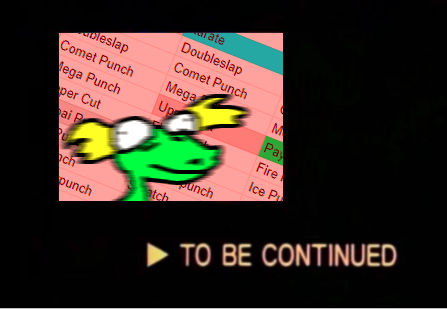
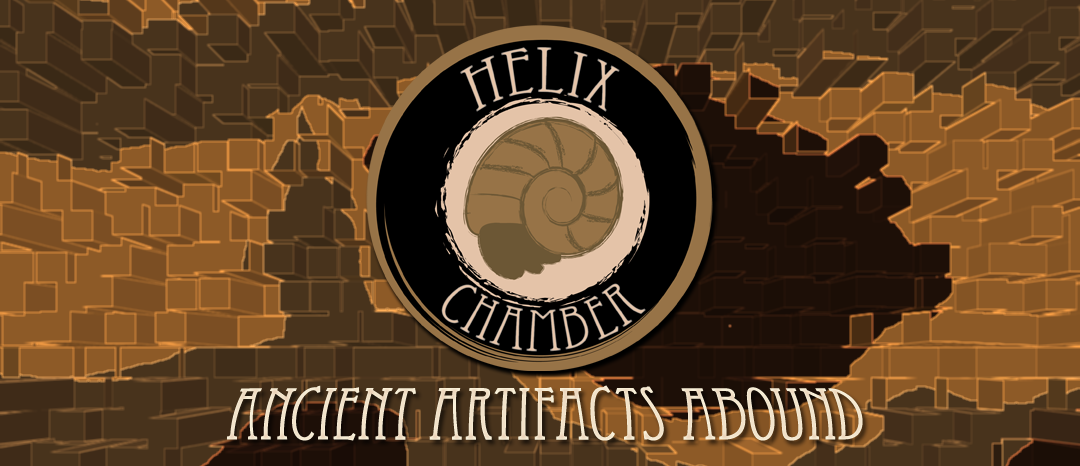
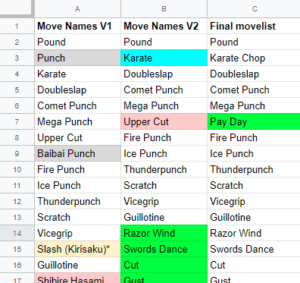
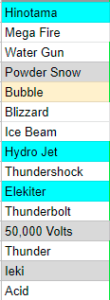
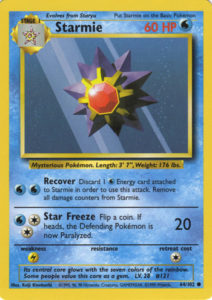

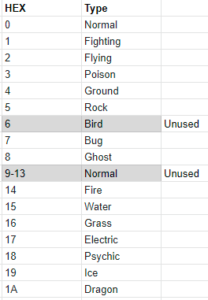
Couldn’t “W Kabe” also be “Double Wall”, and perhaps it would have blocked both special and physical moves? “W” is often used to mean “double” in Japanese.
Amazing, loved it! Small correction (if it helps), the Haunter TCG card is from the Fossil expansion, opposed to Base Set. Can’t wait for Part 2!
Just a small correction: Thunderbolt’s Japanese name is really *100,000* volts — the word ‘man’ means 10,000, and 10 lots of 10,000 gives 100,000. So the 50,000-volt move was probably weaker.
Nice work!
I can see a link between the Ghost and Ground types… Maybe Ghost Pokémon were originally Ground types before they created a separate type for them. Because, you know, you bury the dead. Dead things are under the ground, ghosts come from there. And Cubone and Marowak are Ground-types as well, and they are associated with both the dead, and bones even more so. Plus you can’t forget about the ghost Marowak, and that Cubone were originally found in the Pokémon Tower, you know, the ghost place.
That’s a very interesting point.
Great work as always, HC! Further to your findings:
More possible TCG (cor)relations:
– ほのお/Flare: Growlithe (Base Set 28) —oh, you’ve already mentioned! https://helixchamber.com/2019/02/16/what-dreams-may-come/
– とびかかる/Lunge: Eevee (Vending S1)
– きゅうこうか/Nosedive: Golbat (Vending S1)
S1 came on sale as late as Mar ’98, though. icydk searching for Japanese words on Bulbapedia is handy.
Misc.:
– Bai-bai Punch sounds like a pun of bye-bye and 倍々 / double & multiple
– 2かえし/2-kaeshi sounds like a pun of 倍返し / double payback, more so with the mirror-like effect you’ve found on it
– Shibire *Ha*sami/*Ba*sami are just a variation in rendaku https://en.wikipedia.org/wiki/Rendaku
– Be careful of typo! e.g. みがわり/Substitute
It’s not clear exactly what you are implying in your discussion of Ghost moves being typed Ground in this early list. Are you implying that, originally, the Ground Type was Ghost Type, and that it was changed to Ground when Hex 08 was made into Ghost? Or are you suggesting something else more complicated?
In general, it looks like Bug, Dragon, and Ghost were all added very late- they’re the last types in physical and special, they have almost no moves (and no powerful ones without alternate damage calculations). What other conclusions can we come to about the types? It seems that all the other special types were probably created early on, since a fire/ice/electric triad is clear as early as period two of the internal index pokedex, and ice is the last type before dragon. It sounds like you’re right that rock was split of from ground, which makes sense because those two types seem so superfluous. And fighting and poison types seem created pretty early because they have low index numbers, fighting moves are found even in movelist V1, and so many Pokémon are poison type in gen 1. But what the heck is happening with flying and bird? Was flying originally “wind” and changed to flying when the two types were merged?
Anyway, I can’t wait for the second half of this article, thank you!
Clefairy – Metronome
Spearow – Mirror Move
Voltorb – Self-Destruct
Exeggcute – Egg Bomb
Lickitung – Lick
Gastly? – Smog
Grimer – Sludge
Cubone – Bone Club
Growlithe – Fire Blast
Gyarados – Waterfall
Shellder? – Clamp
Staryu – Swift
Blastoise? – Skull Bash
Cloyster? “Cactus”? – Spike Cannon
Onix – Constrict
Slowpoke – Amnesia
Kadabra – Kinesis
Chansey – Softboiled
Hitmonlee – Hi Kick Jump
Arbok? – Glare
Drowzee – Dream Eater
Koffing – Poison Gas
Exeggcute? Exeggutor? – Barrage
Zubat* – Leech Life
Jynx – Lovely Kiss
Moltres, Articuno, Zapdos – Sky Attack
Ditto – Transform
Krabby? – Bubble
(…)
Mankey? – Dizzy Punch
Venomoth? – Spore
Missingno – Squid Ink
Mewtwo – Psywave
Magikarp – Splash
Muk? – Acid Armor
Kingler – Crabhammer
Cloyster? Magnissingo? Electrode? – Explosion
Persian – Fury Swipes
Marowak – Bonemerang
Abra – Rest
Staryu – Star Freeze
Raticate? – Hyper Fang
Porygon – Sharpen
Porygon – Conversion
Porygon – Tri-Attack
Rattata? – Super Fang
I just have a question, where did you found the 3 photos of pokemons attacking? Thank you.
When’s Part 2 going to be published?
I would say Focus Energy and Bide are in the first category. They’re both attacks meant to concentrate your energy/spirit. Focus Energy makes you more angry to inflict more criticals (or supposed to, anyway) and Bide was the opposite in that it channeled your energy inward to receive attacks. They also use the same animation (for the first part of Bide, anyway).
Ghost types had Ground as their placeholders? Imagine if that’s because corpses are buried, lol